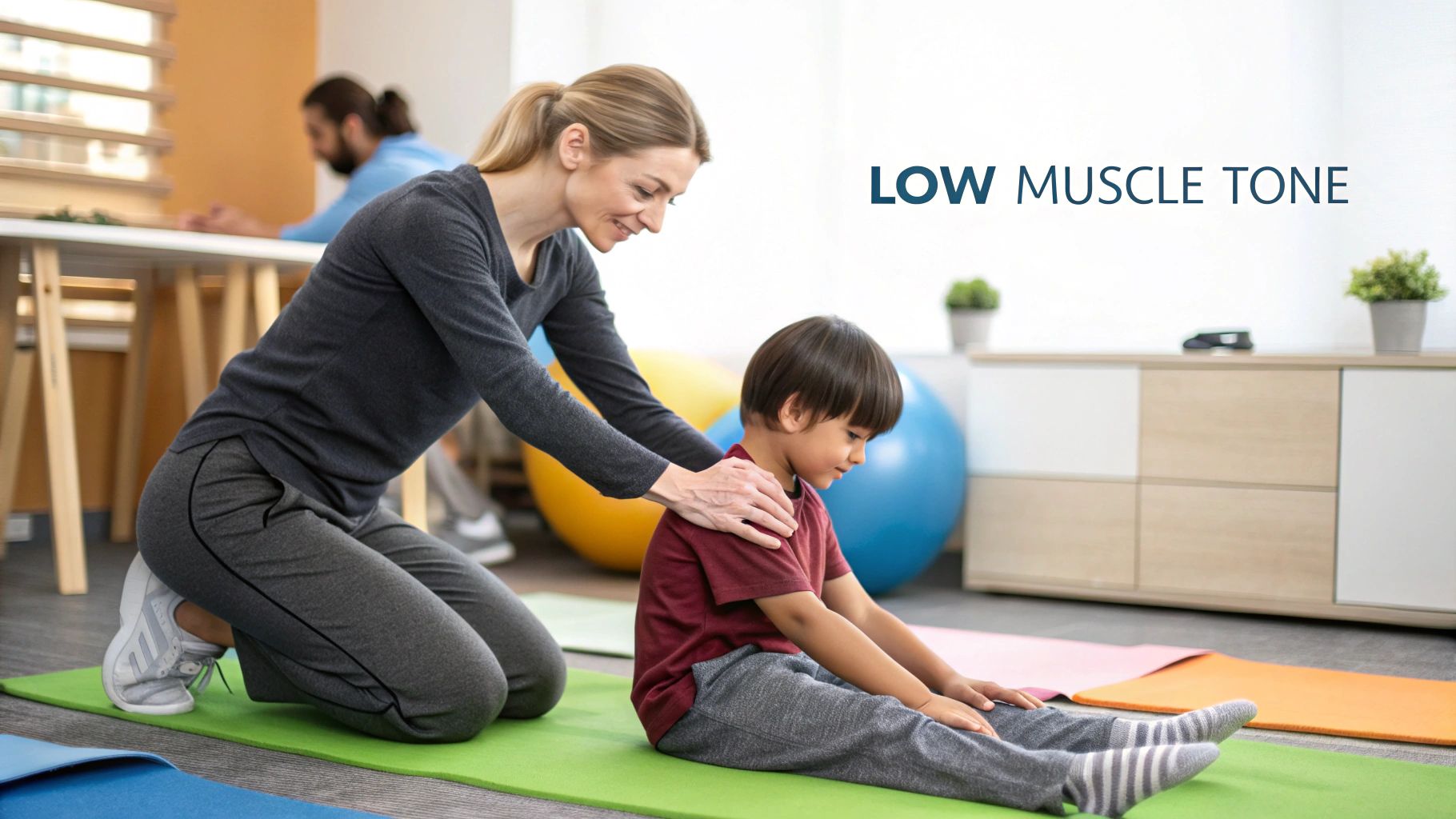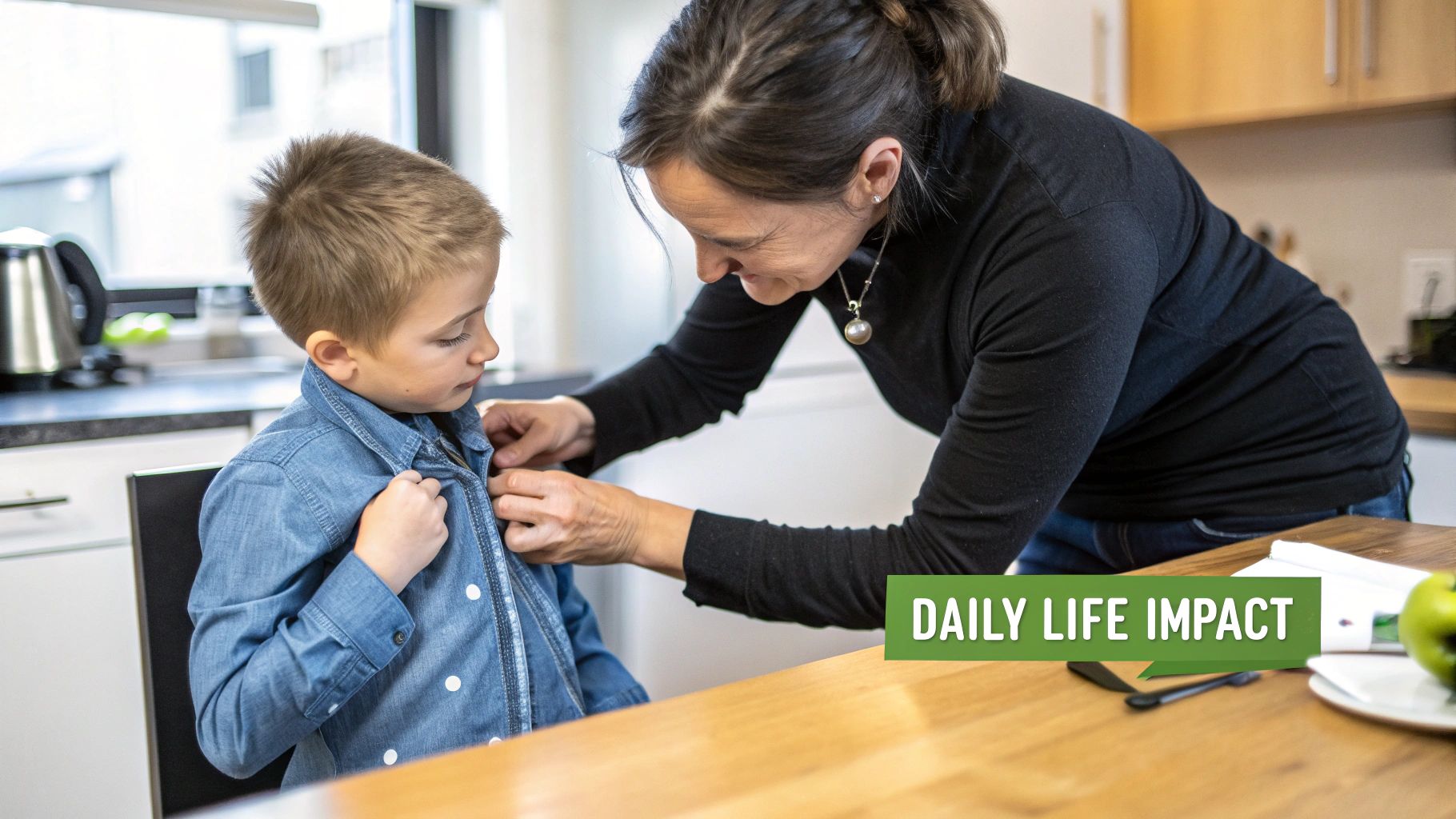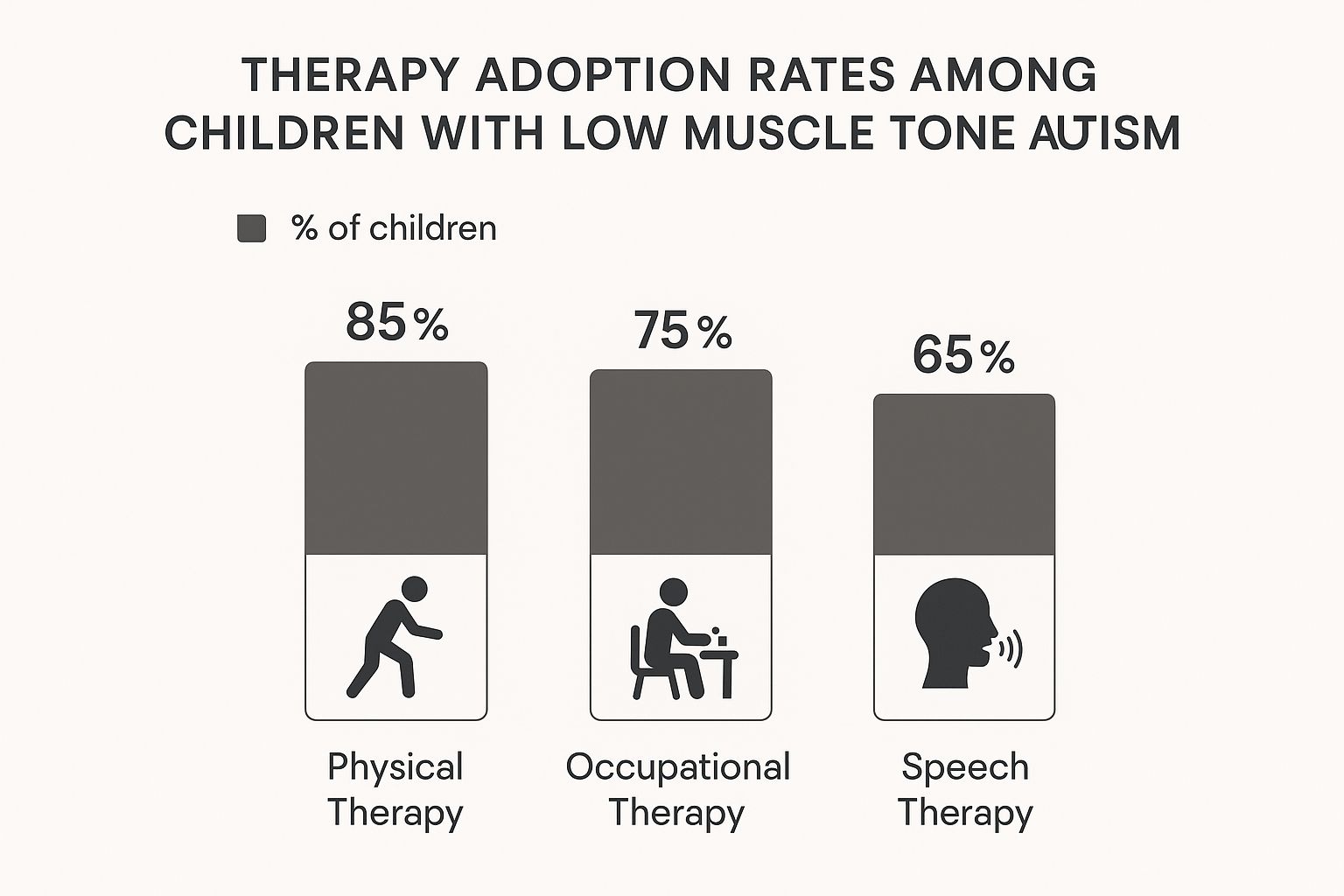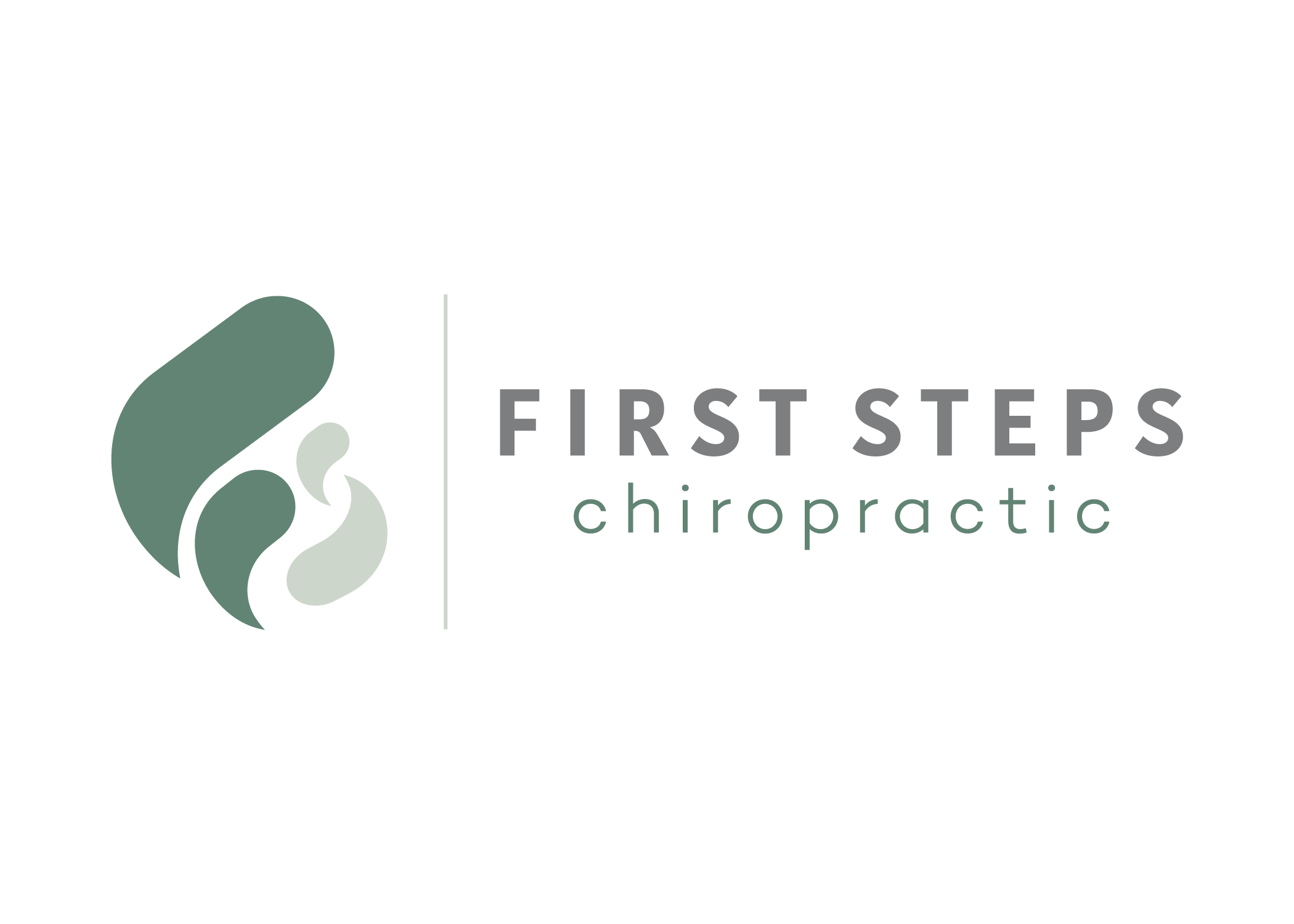When parents first learn that hypotonia, or low muscle tone, is a common trait in children with Autism Spectrum Disorder (ASD), it can open up a whole new level of understanding. This isn't about muscle weakness, but rather a decreased "resting tension" in the muscles that can impact everything from a child's posture to their coordination. Getting a handle on this connection is a huge first step in providing the right kind of support for your child.
Understanding Low Muscle Tone and Its Link to Autism
Let's try an analogy. Think of a marionette puppet. Some are strung tightly, poised and ready to jump into action with the slightest nudge. Others are strung more loosely, and it takes a lot more effort from the puppeteer to get them to stand tall and move with any real precision. A child with hypotonia is a bit like that loosely strung marionette—their muscles simply have a lower baseline level of tension.

This means their muscles have to work overtime just to hold a posture, make a specific movement, or keep up during physical activity. It’s a fundamental difference in how their neuromuscular system operates, not a reflection of weakness or a lack of trying. This constant extra effort is why they might get tired more quickly and find both big and small motor skills challenging.
The Neurological Connection
So, where does this link between hypotonia and autism come from? It's all rooted in the nervous system. The brain is constantly sending signals to our muscles to keep them in a state of readiness, or "tone." For many kids on the spectrum, this internal signaling system can be less efficient, leading to that lower resting tension.
This really drives home the point that motor challenges are often an integral part of the autistic experience. It's not a separate, unrelated issue. In fact, studies show that approximately 50% of children with ASD also have hypotonia. It’s often one of the first signs noticed, with infants appearing 'floppy' because they have less muscle control.
This is so much more than just being "clumsy." Low muscle tone has a ripple effect. It can compromise core stability, making it tough to sit up straight in a classroom chair, hold a pencil the right way, or even manage the oral muscles needed for clear speech and eating.
Why This Understanding Matters
When we recognize that low muscle tone is a physiological part of autism, it completely shifts our perspective from focusing on behavior to providing support. It helps us understand the why behind so many common challenges.
Suddenly, it makes sense why a child might:
- Get exhausted during a trip to the playground
- Prefer sitting with a video game over running outside
- Struggle with handwriting or buttoning a shirt
- Constantly have a slumped or slouched posture
Once you grasp the "why," you can start looking for targeted strategies to help build strength, improve coordination, and make daily life easier and more functional. This foundational knowledge empowers you to find the right therapies and offer compassionate, truly effective support. To dive deeper, check out our detailed guide on the relationship between low muscle tone and the autism spectrum.
Identifying the Signs of Hypotonia in Children with Autism
Figuring out if your child has low muscle tone can feel a bit like detective work, but it really boils down to paying attention to their everyday movements and posture. The term “floppy baby” often comes to mind, but the signs are much more specific than that and they change as your child grows.
Knowing what to look for at each stage helps you have more confident, productive conversations with your pediatrician and other therapists.

This isn’t about searching for problems. It’s about understanding your child’s unique physical makeup. Spotting these signs early is a game-changer. In fact, research shows that muscle hypotonia can be a powerful clinical marker that leads to an earlier diagnosis of Autism Spectrum Disorder.
One important study found that the presence of hypotonia was linked to getting an autism diagnosis sooner—by an average of 1.5 years in boys and about 1 year in girls. Getting that clarity earlier opens the door to the right support at a critical time. You can dive deeper into these connections in the full research findings.
To help you connect the dots, let's break down what low muscle tone can look like at different ages.
Common Signs of Low Muscle Tone Across Developmental Stages
This table breaks down some of the observable signs of hypotonia from infancy through childhood. It’s a helpful guide for parents trying to identify potential concerns at various ages.
| Developmental Stage | Observable Signs and Behaviors |
|---|---|
| Infancy | – Feels limp or "rag-doll-like" when held – Poor head control; head lags when pulled to sit – Difficulty sucking or feeding – Delayed motor milestones like rolling over or sitting up |
| Toddlerhood | – Prefers sitting in a "W" position for stability – Appears clumsy, trips, or falls frequently – Tires quickly during physical play – May have a wide-based gait or walk on flat feet |
| Early Childhood | – Slumps or slides down in chairs – Struggles with playground equipment like monkey bars – Leans on furniture or people for support – Has trouble with activities requiring coordination, like riding a tricycle |
| School-Aged | – Poor posture, especially when sitting at a desk – Awkward or weak pencil grip, leading to messy handwriting – Avoids sports or physical education class – Low endurance; complains of being tired often |
Seeing a sign on this list isn’t an immediate cause for alarm, but noticing a consistent pattern is a good reason to start a conversation with a trusted healthcare provider.
Signs in Infancy
During that first year, the signs of hypotonia are all about a baby’s struggle against gravity. You might notice they feel unusually soft or limp when you pick them up, almost like they could slip right through your hands.
Common giveaways during infancy include:
- Poor Head Control: Difficulty lifting their head or keeping it steady when you pull them into a sitting position.
- Delayed Motor Milestones: Taking longer than their peers to roll over, sit up without support, or do a push-up during tummy time.
- Passive Posture: Lying with their arms and legs splayed out instead of keeping them slightly bent and tucked in.
Signs in Toddlers and Young Children
As kids get on their feet and start exploring the world, the signs of low muscle tone autism become more about posture, coordination, and stamina. You can really see the extra effort it takes for them to move.
You might notice a toddler or young child:
- Adopting a 'W-sit' Position: This is a classic compensation strategy. By sitting on the floor with their knees bent and legs out to the sides, they create a wider, more stable base that requires less core strength.
- Being Extra Clumsy: They may trip over their own feet constantly, stumble more than other kids, or have a tough time climbing playground structures.
- Having Low Endurance: A child with hypotonia might get exhausted much faster than their friends during play, often needing to sit down and rest after just a few minutes of running around.
It's so important for parents to understand that these behaviors aren't about laziness or a lack of motivation. They are the direct result of an underlying physical challenge. Every single movement requires more conscious effort and burns more energy.
Signs in School-Aged Children
Once a child enters a school setting, the demands on their motor skills ramp up, and the signs of hypotonia can become much more obvious.
Weak core strength often leads to a slumped posture at their desk because holding their trunk upright for long periods is simply exhausting. You might also see issues with fine motor skills, like a weak or awkward pencil grip that makes handwriting a tiring, frustrating task. These physical struggles can directly impact a child's ability to focus and learn, which is why motor support is so critical for their overall academic success.
Exploring Why Hypotonia Is So Common in Autism
When parents learn that low muscle tone is a physical sign, one of the first questions that comes to mind is, why is it so deeply connected to autism? The answer isn't in the muscles themselves, but in the intricate communication network that connects the brain, nerves, and muscles in a constant, flowing dialogue.
Think of the nervous system as a sophisticated electrical grid. The brain is the power station, sending out precise signals to keep everything running smoothly. For the muscles, this means receiving a steady, low-level current that tells them to maintain a certain amount of tension, or "tone," even at rest.
In a child with low muscle tone autism, that signal often comes through with a bit of static. The message from the brain to "stay firm and ready" isn't as clear or strong as it needs to be. The muscles don't get that consistent command to maintain their baseline readiness, so they stay in a more relaxed, or hypotonic, state. The problem isn't a faulty muscle; it's a difference in the neurological wiring that controls it.
The Central Nervous System's Role
The central nervous system (CNS)—the brain and spinal cord—is the ultimate command center for muscle tone. Key areas of the brain, like the cerebellum, act as the master coordinators for movement, balance, and posture. For many autistic individuals, these parts of the brain may develop or function a little differently.
This difference can throw a wrench in the otherwise smooth, automatic process of maintaining muscle tone. As a result, a child has to put in far more conscious effort and energy to do things that come naturally to others, like sitting up straight at a desk or keeping their joints stable while running and playing.
Proprioception: Your Body's Internal GPS
Another huge piece of the puzzle is proprioception, which is basically the body's internal GPS. This is the sense that tells us where our arms and legs are in space without us having to look. It works through tiny receptors in our muscles and joints that send a constant stream of information back to the brain.
For many children with autism and low muscle tone, this internal feedback loop is fuzzy and unreliable.
- Poor Positional Awareness: When the brain doesn't get a clear map of where the limbs are, it has a tough time sending back the right instructions for smooth, coordinated movements.
- Difficulty Grading Movement: They often struggle to judge how much force is needed for a task. This can look like slamming a cup down when they mean to place it gently, or not pushing hard enough on a crayon.
- Seeking Sensory Input: This directly explains behaviors like stomping, crashing into furniture, or craving deep pressure hugs. Their bodies are desperately trying to generate enough sensory feedback to figure out where they are.
When this internal GPS is on the fritz, just maintaining posture and moving gracefully becomes a major challenge, which is a big reason why hypotonia is so visible.
"Think of it this way: If you couldn't feel where your feet were without looking, walking across a room would become a complex, deliberate task instead of an automatic one. This is the daily reality for many children navigating low muscle tone."
The Neuromuscular Junction: A Key Connection Point
If we zoom in even further, scientists are now finding a biological basis right down at the microscopic level. The neuromuscular junction (NMJ) is the critical point where the very end of a nerve meets a muscle fiber to pass along an instruction.
Fascinating new research suggests that in ASD, there can be subtle issues right at this connection point. Studies have found that the signals being passed from nerve to muscle can be less effective, which could be one of the fundamental biological roots of low muscle tone autism. This is powerful evidence that hypotonia isn't a behavioral choice but a true physiological reality. You can read more about the fascinating neuromuscular mechanisms currently being explored.
Ultimately, understanding these underlying neurological and biological factors is incredibly empowering. It helps us shift our perspective from seeing a child who is "clumsy" or "unmotivated" to seeing a child whose body is working overtime just to navigate a world that demands constant physical adaptation.
How Low Muscle Tone Impacts a Child's Daily Life
When a child with autism has low muscle tone, it’s so much more than just occasional clumsiness or poor posture. Think of it like a building with a slightly unstable foundation. The structure still stands, but every single room is affected in small, almost invisible ways. For a child, when their core stability is compromised by hypotonia, the effects ripple outward, touching nearly every part of their day.

This constant, unseen effort to just hold themselves up can be completely draining. The physical fatigue that comes from simply sitting upright can wipe out a child's energy for anything else. This is exactly why you might see a kiddo lose steam on the playground long before their friends, choosing to sit on the sidelines instead of joining the fun.
Challenges in the Classroom and at Home
The classroom is often where the downstream effects of low muscle tone become impossible to ignore. A child who struggles with core strength might find it physically exhausting to just sit upright at their desk for an extended time. This often leads to fidgeting, slumping, or constantly shifting around—behaviors that can easily be mistaken for defiance or not paying attention.
Beyond just sitting still, fine motor skills are also a huge hurdle. Weakness in the hand and finger muscles turns tasks like writing into a frustrating, tiring ordeal.
Common struggles at school and home often include:
- Handwriting Difficulties: Holding a pencil the right way and applying even pressure can feel like a monumental task, leading to messy work and painful hand cramps.
- Trouble with Fasteners: Buttoning a shirt, zipping up a jacket, or tying shoelaces all require a level of dexterity that can be incredibly hard to muster.
- Using Utensils: Trying to effectively manage a fork and knife can be a struggle, which can make mealtimes feel more like a chore than a time to connect.
These daily hurdles aren't about a child not trying hard enough. They're direct consequences of a physiological condition that demands more energy and conscious effort for tasks that others do without a second thought. Supporting their motor skills is fundamental to building their confidence and independence.
The Connection Between Motor Skills and Cognition
The impact of low muscle tone doesn't stop with physical tasks, either. A growing body of research is showing us just how deeply motor function and cognitive processes are intertwined. When a child's brain and body have to dedicate a huge amount of resources just to maintaining balance and posture, there are fewer resources left over for higher-level thinking, like focusing, listening, and processing what the teacher is saying.
This isn't just a theory; quantitative research backs it up, showing a consistent link between reduced muscle strength and Autism Spectrum Disorder. Crucially, studies have found that as muscle strength increases, so does performance in executive functioning and information processing. This really highlights the powerful connection between the motor and cognitive worlds in autism. To dig deeper into this, you can learn more about these important findings.
Social and Emotional Consequences
Finally, the physical limitations that come with low muscle tone autism can have a profound social and emotional impact. A child who simply can't keep up on the playground might miss out on those vital, spontaneous moments where friendships are built and social skills are learned.
Feeling physically less capable than their peers can slowly chip away at self-esteem. It can lead a child to start avoiding group activities altogether, from sports to simple playground games. Over time, this can lead to feelings of isolation and anxiety. Recognizing and addressing the physical roots of these challenges is a critical step in supporting a child’s overall emotional well-being, helping them engage with their world more confidently and joyfully.
Effective Therapies That Build Strength and Coordination
When you’re dealing with low muscle tone in a child with autism, a "wait and see" approach just doesn't cut it. What you need is a proactive, collaborative team of specialists who truly get your child's unique needs. The goal is to work together to build their strength, coordination, and confidence from the ground up.
A truly effective plan looks at the whole child, not just one isolated issue. It means weaving together different therapies that complement each other, targeting everything from core stability and big movements to the delicate motor skills they need for everyday life.
Let's break down the key players on this collaborative care team.
Physical Therapy: The Foundation Of Strength
Physical Therapy (PT) is almost always the cornerstone of treatment for hypotonia. Think of a physical therapist as a personal trainer for your child’s entire body, focused on building the foundational strength needed for all those big gross motor skills.
They have a knack for making therapy feel like pure fun, using engaging activities and play to target specific muscle groups.
The main goals of PT usually include:
- Building Core Strength: Therapists use exercises like animal walks (think bear crawls and crab walks) and fun activities on therapy balls to strengthen the muscles in the trunk. A strong core is the anchor for every other movement.
- Improving Balance and Coordination: Walking on balance beams, navigating obstacle courses, and practicing single-leg stances all challenge the body's internal GPS (proprioception). This helps your child become more stable and less clumsy.
- Enhancing Endurance: Through structured play, PT helps increase a child's stamina, so they can keep up on the playground and participate in activities for longer without getting totally wiped out.
Occupational Therapy: Skills For Daily Living
While PT builds the big-picture foundation, Occupational Therapy (OT) zooms in on the fine motor skills and sensory processing needed to successfully navigate daily life. An occupational therapist helps a child master the practical, hands-on tasks that are so important for independence and self-esteem.
Basically, an OT is a life skills coach. They work on the precise movements required for school, self-care, and play.
Occupational therapy bridges the gap between a child's physical abilities and their ability to successfully participate in their "occupations"—which for a child means playing, learning, and growing.
An OT session might be focused on:
- Hand Strengthening: Using things like therapy putty, squishy balls, and clothespins to build up the small muscles in the hands needed for a good pencil grip.
- Self-Care Routines: Breaking down tasks like buttoning a shirt, zipping a coat, or using a fork into small, manageable steps.
- Sensory Integration: Providing specific sensory input that helps the nervous system better understand where the body is in space, which is absolutely crucial for coordinated movement.
The image below shows just how often parents turn to these key therapies to support children with low muscle tone and autism.

The data makes it clear: Physical and Occupational Therapy are the most common interventions, which really highlights how vital they are for building motor skills.
To help you see how these therapies fit together, here’s a quick comparison of the different approaches.
Comparing Therapeutic Approaches for Low Muscle Tone
| Therapy Type | Primary Focus Area | Key Benefits and Activities |
|---|---|---|
| Physical Therapy (PT) | Gross Motor Skills & Core Strength | Builds foundational strength for walking, running, and jumping. Uses activities like obstacle courses, balance beams, and therapy balls. |
| Occupational Therapy (OT) | Fine Motor Skills & Daily Living | Develops skills for self-care (dressing, eating) and school (handwriting). Uses therapy putty, puzzles, and sensory integration tools. |
| Specialized Chiropractic | Nervous System Communication | Improves the brain-body connection for better muscle activation and tone. Uses gentle, neuro-tonal adjustments. |
| Speech-Language Therapy | Oral-Motor Control & Articulation | Strengthens muscles in the jaw, tongue, and lips for clearer speech and safer eating. Involves targeted exercises and sound practice. |
Each of these therapies plays a crucial role, and when they work in concert, the results can be much more powerful than any single approach on its own.
The Role Of Specialized Chiropractic Care
Beyond the traditional therapies, specialized pediatric chiropractic care offers a unique and powerful way to support a child with hypotonia. Our approach zeroes in on the root of the issue: the communication highway between the nervous system and the muscles. A pediatric chiropractor works to make sure the brain can send clear, strong signals to the body.
If the nervous system is the body's wiring, a chiropractor is like an electrician, checking for any interference that might be scrambling the signals.
Using gentle, neuro-tonal techniques, we can help improve the efficiency of this communication pathway. When the brain and muscles are talking to each other more effectively, we often see better muscle activation, improved posture, and enhanced coordination as a result.
This neurological focus is why chiropractic care can be such a valuable piece of the puzzle. It doesn't replace PT or OT. Instead, it works alongside them to support the body's underlying function. You can learn more about how chiropractors can help children with autism by supporting their nervous system health.
By helping create a more balanced and connected system, all other therapies can become more effective, helping your child make even greater strides toward their developmental goals.
Fun At-Home Activities to Support Your Child's Motor Skills
Supporting your child's development doesn't stop when you leave the therapy room. In fact, your home is one of the most powerful places for building strength and coordination.
By weaving fun, playful activities into your daily routine, you can reinforce the skills they’re learning and see incredible progress. The trick is to make it feel like a game, not a chore. This transforms everyday moments into powerful opportunities for growth.
Strengthening the Core with Playful Movement
A strong core is the foundation for just about every movement your child makes, from sitting up straight to running across the playground. When we're working with low muscle tone autism, core work is always a top priority—but it doesn’t have to be boring!
- Animal Walks: Challenge your child to move across the room like their favorite animals. A bear crawl (walking on hands and feet) is fantastic for shoulder stability and core engagement. A crab walk (scuttling sideways on hands and feet with their belly up) strengthens the back, glutes, and arms.
- Wheelbarrow Walking: This classic game is an absolute powerhouse for building upper body and core strength. Just hold your child's legs while they walk forward on their hands. Start with short distances and celebrate every single step.
The goal here is to activate those trunk muscles in a dynamic, fun way. This helps improve postural control, which is essential for everything from sitting attentively in class to keeping their balance during play.
Boosting Balance and Coordination
Improving balance and coordination helps a child feel more confident and secure in their body. These skills reduce clumsiness and make it so much easier for them to jump into physical activities with their friends.
You don't need fancy equipment; your living room can become the ultimate training ground.
- Living Room Obstacle Course: Use pillows, couch cushions, and blankets to create a simple course. Have your child crawl under a table (the "tunnel"), walk along a line of tape on the floor (the "balance beam"), and step over a row of stuffed animals.
- Balloon and Bubble Fun: Tapping a balloon back and forth is an excellent way to work on hand-eye coordination and reaction time. And who doesn't love chasing and popping bubbles? It encourages running, jumping, and reaching, all of which help with balance and motor planning.
Building Fine Motor Skills with Hands-On Activities
Weak hand strength can make everyday tasks like writing, buttoning a shirt, or using a fork and knife incredibly frustrating. Building up these small but mighty muscles is crucial for your child's independence.
Get their hands engaged with sensory-rich activities they’ll love:
- Play-Doh and Therapy Putty: Squeezing, rolling, and pinching putty or dough is a fun and seriously effective way to strengthen hand and finger muscles. For an extra challenge, hide small beads inside for them to find and dig out.
- Spray Bottle Games: Fill a small spray bottle with water and let them spray plants or "clean" the windows. It's a great way to build hand strength, and the trigger action works the exact muscles needed for using scissors.
Integrating these activities can make a world of difference in your child's progress. But motor challenges often go hand-in-hand with sensory ones. For more insights on that piece of the puzzle, you can explore our guide on approaches to sensory processing disorder therapy.
By being an active partner in their development, you empower your child to build skills and confidence every single day.
Frequently Asked Questions
When you're navigating the world of low muscle tone and autism, it’s completely normal to have a lot of questions. As a parent, you want to understand what's happening and how you can best support your child. Below, I’ve answered some of the most common concerns I hear from families, hopefully giving you some clarity and confidence as you move forward.
Can a Child Outgrow Low Muscle Tone?
This is a fantastic question. While the underlying neurological reason for hypotonia isn't something a child just "grows out of," their functional strength and coordination can absolutely improve—often dramatically. We don't aim to "cure" the low tone itself.
Instead, our focus is squarely on building muscle strength around the joints. We teach the body new, more effective ways to create stability, hold good posture, and execute motor skills. This isn't about fixing a problem; it's about empowering your child to participate in daily activities with more confidence and ease.
Is Low Muscle Tone the Same as Muscle Weakness?
It's easy to see why these two get confused, but they are different concepts. Think of it this way: low muscle tone is about the amount of tension in a muscle when it's just hanging out, at rest. It's a lower starting point for activation.
Muscle weakness, on the other hand, is about the muscle's ability to actually generate force when you ask it to move. Kids with hypotonia often have muscle weakness because their muscles have to work so much harder to get going from that low resting state. So, while they're related, the terms aren't interchangeable. Our goal in therapy is always to build strength to make up for that low underlying tone.
A key takeaway is that low muscle tone is a neurological trait, not a lack of effort. Building strength is the primary strategy to improve function and stability.
How Can I Get a Formal Diagnosis for Hypotonia?
If you’ve been noticing challenges with your child's motor skills or suspect they might have low muscle tone, the best first step is always to talk with your pediatrician. They can do an initial physical exam and give you a sense of what might be going on.
From there, you'll likely get a referral to a specialist who can dig deeper and provide a clear diagnosis. This will probably be one of these experts:
- Pediatric Neurologist
- Developmental Pediatrician
- Physical Therapist
These professionals have specific assessments to measure muscle tone, strength, and overall motor function. Their evaluation will lead to a formal diagnosis and, most importantly, help map out the perfect therapy plan for your child.
At First Steps Chiropractic, we specialize in supporting the neurological development of children with low muscle tone and autism. Our gentle, neuro-tonal approach is all about improving that brain-body connection, which can make other therapies even more effective and empower your child to truly thrive. Schedule a complimentary consultation today to learn how we can help.

